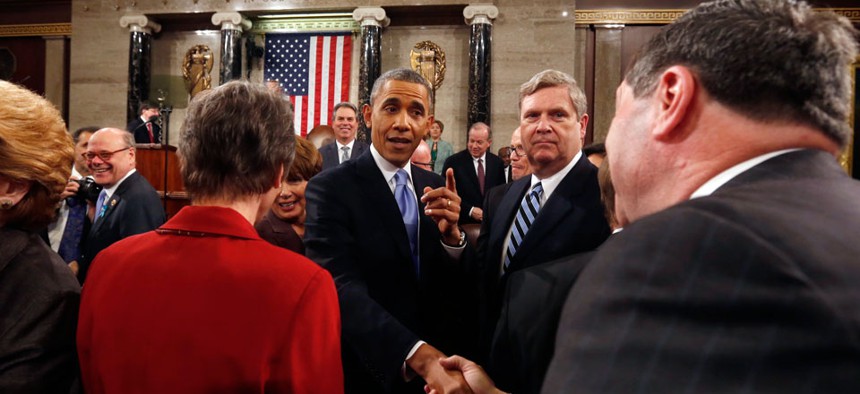Have Presidential Speeches Gotten More 'Tweetable'?

President Barack Obama shakes hands as he leaves after giving the State of Union address. Larry Downing/AP
Not really, but the speech is but one piece of the spectacle of the State of the Union.
The White House regularly tweets sentences from key (and also from not-so-key) speeches on its various feeds. Which made Yahoo's News Chris Wilson and Olivier Knox wonder "whether the president's speechwriters were actually crafting his speeches to fit in Twitter-friendly increments." Perhaps it would stand to reason that presidential speeches, like so much else, have been influenced by the platform.
Turns out? Not so much. Wilson and Knox created a tool that measures the "tweetability" of text —which is, as they define it, "a measure of how many sentences fall below the 120-character mark" (since "most social media consultants say tweets should leave at least 20 characters free for retweeting"). The resulting rating is a percentage of the sentences that fall below 120. And while those ratios are, of course, extremely rough estimates—"tweetability" is about much more than mere sentence length alone—the tool offers a general idea of the length of presidential speeches as they play out over time, at the atomic unit of Twitter: the sentence itself.
But when I ran the transcripts of the past 15 years' worth of speeches through the tool, I could find no trends toward tweetability. The opposite, in fact: The past two years' speeches ranked much lower on the tweetability scale than did the speeches delivered between 2010 and 2012. And George W. Bush, who took office long before Twitter came on the scene, had much more Twitter-friendly speeches, according to Yahoo's metric, than Barack Obama.

This isn't to say that White House communications teams don't think about tweetability when they're crafting their speeches; of course they do. It's just that tweetability comes down to much more than character count—and, for that matter, to much more than text. Sure, the perfect, resonant sound bite—"it's morning in America," "read my lips," "where's the beef" (sound bites, alas, need not be poetry)—is a time-honored goal of political writing. And, sure, social media have generally altered the calculus of political engagement. They've mostly done so, though, not by changing the text of speeches, but by changing the context.
That's because speeches, when TV collides with livestreaming (collides with Twitter, collides with YouTube, collides with Vine), are no longer simply speeches. The State of the Union has become (sorry! but) a state of mind . All the traditional pageantry of the president's Constitutionally mandated update has extended into a weeks-long extravaganza of ambient spectacle. The White House previewed last night's speech on Instagram (via shots from speechwriter Cody Keegan, press secretary Jay Carney, and others); it offered "Behind the Scenes" videos on YouTube, published to WhiteHouse.gov's dedicated "SOTU 2014" page ; it sent mass emails with subjects like "Before I go on:" and "Tonight." And the Republican response to the speech included not just highly orchestrated speeches from the mainstream and the Tea Party, but also impromptu YouTube hits and Vines from other members of Congress, shot in the iPad-filled studio the GOP had commandeered for the occasion .
Last night's speech, in other words, was the culmination of a broad political posture, a tacit recognition that the work of persuasion cannot be confined to a chunk of primetime air. It wasn't just a speech. It wasn't primarily a speech. The reactions to it—which defined 'tweetability' in the broadest terms possible—reflected this. Often, they bypassed the speech's words altogether in favor of its images. The historian Daniel Boorstin described (and condemned) pseudo-events, contrived spectacles that are custom-made for the machinery of mass media. The title of his book is The Image . It was published in 1962. Last night, it was looking pretty prescient.


